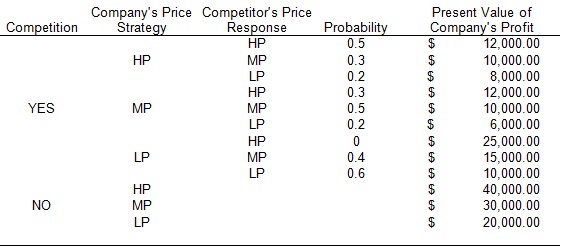Case scenario:
Suppose that the Beauty Company faces the choice of introducing a new beauty cream or investing the same amount of money in Treasury bills with a return of $10,000.00. If the company introduces the beauty cream, there is an 80 percent probability that a competing firm will introduce a similar product and a 20 percent chance that it will not. Whether or not the competitor responds with a similar product, the company has a choice of charging a high, a medium, or a low price. In the absence of competition this is the end of the story. In the presence of competition, the competitive firm can react to each price strategy of the Beauty Company with a high, medium, or low price of its own. The probability and the present value of the company’s profit under each competitor’s price response for the company strategy of high price (HP), medium price (MP), and low price (LP) are indicated in the table below. Construct a decision tree and determine whether the Beauty Company should introduce the new beauty cream or use its funds to purchase Treasury bills.

After calculating the expected present value of company's profit under different price strategies, first, choose the price strategy which produces the highest expected present value of profit with competition and without competition (hint: competition with LP), second, calculate the expected present value of company's profit using the probabilities of 80% and 20%, and then compare it with the certain return of $10,000 that the company receives by investing in Treasury Bills.